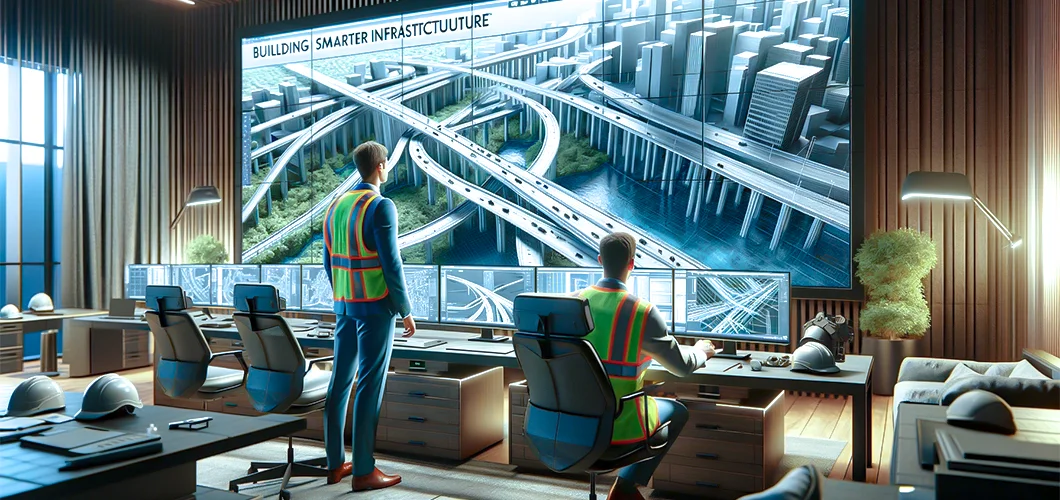
BIM for Civil Engineers – Building Smarter Infrastructure
Do you wish to know how civil engineers make the most of BIM for carrying out their day-to-day operations? And would you also want to utilize BIM for one of your upcoming projects? If the answer to both questions is yes, then know that you have come to the right place.
In this blog, we aim to focus on how BIM has transformed the world of civil engineering. In addition, we would also like to discuss how BIM facilitates civil engineers so that they can shape modern societies. Make sure that you read the blog till the end to know how civil engineers build smarter infrastructures.
What Exactly is Building Information Modeling (BIM)?
To understand BIM for civil engineers, you must know what exactly BIM is, right? Allow us to briefly talk about BIM so that we can proceed with the main topic of the blog.
Okay so, Building Information Modelling (BIM) is the digital representation of the physical and functional characteristics of a place. BIM is more than having access to 2D drawings in a construction project as it extends to 3D models. These highly intricate 3D models are loaded with insightful information which is crucial for informed decision-making. BIM not only offers information concerning spatial relationships between building elements but also covers materials, their quantities, etc. BIM is extremely helpful throughout the lifecycle of the project; be it conception or pulling a building down.
BIM For Civil Engineers
BIM is a powerful tool for civil engineers as it has revolutionized the way they plan, design and build a modern society. BIM for civil engineers offers innovative technologies so that they can achieve their goals by working in collaborative environments. These environments allow streamlined workflows, enhanced efficiency as well as improved integration of sustainable practices.
Moreover, BIM also facilitates civil engineers to immerse themselves in virtual environments in which they can visualize the project even before the construction phase. Since roads, dams, bridges, etc. are large-scale projects, every stakeholder must go in prepared. And it is BIM that allows them to work in complex environments without any difficulty efficiently.
Once the civil engineers are present in virtual environments, they can fully understand all that’s going to happen, when and how. Do you know what that means? It means that the civil engineers can coordinate and collaborate with other project teams to view, analyze and discuss the way forward – while also making the project error-free. By integrating BIM into a construction project, the stakeholders make the most of the collaborative environment to ensure successful project delivery.
Let’s have a look at how BIM is playing its role in making modern infrastructures more sustainable and cost-effective!
1. Enhanced Designing & Planning
BIM tools enable civil engineers to efficiently work on projects by enjoying enhanced design and planning capabilities. The software not only facilitates the creation of highly detailed 3D models but also offers early clash detection. By leveraging BIM into the projects, the stakeholders can work towards the resolution of potential threats that can impact the project’s progress. And the best thing is that it all happens while the project is still in its design phase. This not only saves a lot of time and effort but also ensures that the budgets are spent wisely and where necessary.
We are sure that you guys know how BIM helps stakeholders in building small-scale structures. However, when it comes to large-scale projects such as roads, airports, etc., BIM also encompasses factors like traffic flow and runway configurations. In addition, BIM enables civil engineers to ensure that they are not harming the environment. This happens when all the stakeholders are serious towards the use of sustainable materials and practices.
2. Streamlined Workflows
To ensure the success of any project, the workflows must be streamlined – otherwise, the stakeholders can face challenges like inefficiency and unwanted delays. One of the benefits of BIM in civil engineering is that it offers streamlined workflows in every sense of the word. Allow us to share what we mean in this part of the blog!
When civil engineers leverage BIM into their projects, they get access to accurate and highly detailed information. This information is super beneficial for making all sorts of decisions at every stage of the project. Also, these decisions can be both big and small but know that all of them have a direct impact on the project. So, it’s imperative to stay on the right track as deviating from it can badly impact the project and the stakeholders.

Starting from the construction phase; the acquired information from surveying allows contractors to work on construction schedules. In addition, they also generate construction sequences while also minimizing all sorts of errors. By doing so, they can ensure that the project deadlines and requirements are met the way everyone has anticipated. Also, BIM offers seamless coordination among stakeholders for onsite happening so everyone is on the same page.
We must also mention that BIM enables the project teams to monitor and manage all the operations as and when they are being processed.
3. Cost-Effectiveness
We understand how crucial budgets are for a construction project. We are glad to share that BIM only offers cost-effective solutions so that everyone can keep moving towards their common goal without putting a dent in their pockets.
In this part of the blog, we would like to talk about how the integration of BIM ensures cost and time-saving in construction projects. And if you have come this far, we are sure that you are finding the blog super useful. So, make sure that you keep reading it till the end to make informed decisions for yourselves and your clients.
We have mentioned several times that BIM offers cost-effective solutions for every construction project. But how exactly does the software do that? By leveraging BIM in a project during the initial stages, the stakeholders can efficiently detect clashes. Their next step is to resolve those clashes by suggesting modifications in the design phase only. So, the designs are revised and shared with the concerned personnel who can then approve them. This practice saves the project teams from costly reworks which would otherwise result in environmental and financial impacts.
We would also like to share that when coordination and collaboration occur among interdisciplinary teams, it not only boosts their confidence but also makes achieving desired outcomes easier.
Suggested: Best Practices for Accurate BIM-based Cost Estimation
4. Improved Sustainability
Speaking of BIM offering cost-effective solutions, we must also talk about how it plays an active role in improving sustainability. BIM has become a preferred choice among construction professionals because, unlike traditional building methods, it promotes the use of sustainable practices. In addition to that, BIM is also helpful in making construction projects more resilient and smarter. Here are a few ways in which BIM has proved to be crucial for ensuring sustainability:
With BIM, the project teams can incorporate energy-efficient solutions such as the use of smart heating, ventilation, and air conditioning (HVAC) systems. In addition, passive solar panels can also be used in infrastructures where such energy sources are required. Although with BIM, the project teams can enjoy accurate resource allocation civil engineers must also ensure that they don’t encourage material waste during the construction phase.
In addition to that, green building principles can also be explored as they facilitate the implementation of strategies that won’t impact the environment. Moreover, selecting and using local building materials is another highly sustainable practice and also helps in reducing the carbon footprint.
5. Enhanced Asset Management

BIM continues to help build smarter infrastructures and its ability to offer enhanced asset management and maintenance is yet another proof of that. By leveraging BIM in a project, civil engineers can ensure that they have accurate data on building materials and equipment. In addition, BIM also facilitates scheduling major and minor operations along with maintenance data.
When the stakeholders have access to such detailed data, they can stay involved with the project even after its completion. After the project has been completed successfully, it’s the responsibility of the facility managers to schedule maintenance. However, the stakeholders can optimize the required operations which will also enable them to increase the structures’ lifespan.
BIM-Related Challenges in Civil Engineering
While BIM has and will continue to transform the way construction professionals work, its use also poses a couple of challenges. For example; BIM is way too different from conventional building methods. It requires the project teams to have the necessary knowledge and skills to fully utilize what it has to offer. The cultural shift among project teams can be confusing and also time-consuming which will eventually impact the project’s progress.
In addition, the software licences come with a cost that can result in budget constraints. And quite frankly speaking, we are well aware that not everyone is willing to pay the extra cost to get things things done. While it’s understandable to some extent, the major drawbacks of not incorporating BIM into projects can range from inefficiency and inaccuracy in the results to unresolved conflicts and more.
So, if you or someone you know would like to make the most of BIM while not wanting to face any challenges in projects then get in touch with DDC Solutions today.

One Response